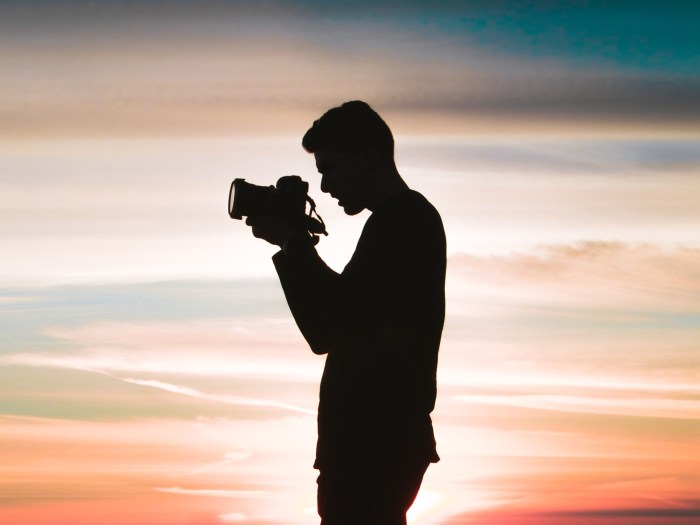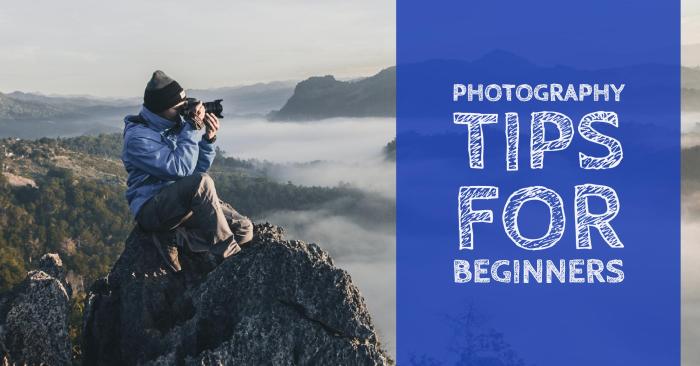Photography Tips for Beginners takes center stage, beckoning readers into a world filled with camera basics, essential equipment, composition techniques, lighting tips, and post-processing magic. Get ready to level up your photography game!
Understanding Camera Basics
In photography, understanding the basics of your camera is essential to capturing great shots. Three key settings to master are aperture, shutter speed, and ISO. Let’s break down how each of these settings impacts your final image.
Aperture
Aperture refers to the size of the opening in the lens through which light passes. A wider aperture (lower f-stop number) lets in more light, resulting in a shallower depth of field and a blurred background. On the other hand, a smaller aperture (higher f-stop number) allows less light in, resulting in a greater depth of field with more of the scene in focus.
Shutter Speed
Shutter speed determines the amount of time the camera’s shutter is open to allow light in. A faster shutter speed freezes motion, while a slower shutter speed creates motion blur. Adjusting the shutter speed can help you capture fast-moving subjects or create artistic effects like light trails.
ISO
ISO measures the camera sensor’s sensitivity to light. A lower ISO is ideal for bright conditions, while a higher ISO is used in low light situations. However, higher ISO settings can introduce noise or grain to your images. Finding the right balance between ISO and other settings is crucial for achieving well-exposed photos.
By understanding how aperture, shutter speed, and ISO work together, you can take more control over your photography and create stunning images tailored to your vision.
Essential Equipment for Beginners: Photography Tips For Beginners

When starting out in photography, having the right equipment can make a huge difference in the quality of your photos. Here are some essential pieces of gear that every beginner photographer should consider investing in:
Camera
A good camera is the most important piece of equipment for any photographer.
– DSLR or Mirrorless: Choose a camera that fits your budget and needs. Consider factors like sensor size, resolution, and ease of use.
Lenses
Lenses are crucial for achieving different perspectives and effects in your photos.
– Prime and Zoom: Prime lenses offer better image quality, while zoom lenses provide versatility.
– Wide-angle, Standard, Telephoto: Invest in a variety of lenses to cover different focal lengths and shooting scenarios.
Tripod
A tripod helps stabilize your camera for sharper images, especially in low light situations.
– Consider the weight, height, and stability of the tripod when choosing one for your gear.
Camera Bag, Photography Tips for Beginners
A camera bag protects your equipment and makes it easier to carry everything around.
– Backpack or Shoulder Bag: Choose a bag that fits your gear comfortably and provides adequate protection.
Memory Cards
Memory cards store your photos and videos, so having extras is always a good idea.
– Choose high-capacity and high-speed memory cards to ensure you can capture all your moments without running out of storage.
Cleaning Kit
Keeping your gear clean is essential for maintaining its performance and longevity.
– Invest in a cleaning kit with tools like a lens cloth, air blower, and cleaning solution to keep your equipment spotless.
External Flash
An external flash can enhance your lighting options and improve the quality of your photos.
– Look for a flash that is compatible with your camera and offers adjustable settings for different lighting conditions.
Remote Shutter Release
A remote shutter release allows you to take photos without touching the camera, reducing the risk of camera shake.
– Consider whether a wired or wireless remote shutter release best suits your shooting style.
Camera Strap
A comfortable camera strap helps distribute the weight of your gear and prevents neck strain.
– Choose a strap that is padded and adjustable to ensure maximum comfort during long shooting sessions.
Composition Techniques

When it comes to photography, composition is key to creating visually appealing images that capture the viewer’s attention. By understanding and utilizing different composition techniques, you can take your photography skills to the next level.
The rule of thirds is a fundamental principle in photography that involves dividing your frame into nine equal sections using two horizontal and two vertical lines. Placing key elements of your subject along these lines or at their intersections can create a more balanced and visually interesting composition. This technique helps draw the viewer’s eye to the most important parts of the image, making it more engaging and dynamic.
Leading lines are another powerful composition technique that can guide the viewer’s gaze through the image. These lines can be actual lines in the scene, like a road or a fence, or implied lines created by the arrangement of elements in the frame. By using leading lines, you can create depth, perspective, and movement in your photos, adding visual interest and drawing the viewer into the scene.
Balancing elements within the frame is crucial for creating harmony and visual appeal in your photographs. Pay attention to the placement of different elements, such as colors, shapes, and textures, to ensure that they work together cohesively. Avoid cluttering the frame with too many distractions and strive for a clean, well-balanced composition that highlights your main subject.
Rule of Thirds
- Divide your frame into nine equal sections using two horizontal and two vertical lines.
- Place key elements at the intersections or along the lines for a balanced composition.
- Draw the viewer’s eye to the most important parts of the image for visual impact.
Leading Lines
- Guide the viewer’s gaze through the image using actual or implied lines.
- Create depth, perspective, and movement in your photos.
- Add visual interest and draw the viewer into the scene.
Balance Elements
- Pay attention to the arrangement of colors, shapes, and textures in the frame.
- Avoid clutter and aim for a clean, well-balanced composition.
- Highlight your main subject by balancing other elements around it.
Lighting Tips for Beginners
When it comes to photography, lighting is everything. It can make or break a photo, so it’s important to understand how to work with different lighting situations.
Natural vs. Artificial Lighting:
Natural lighting refers to light sources like the sun or moon, while artificial lighting includes things like lamps or flashes. Natural lighting can create a soft and warm feel, while artificial lighting can be more controlled and consistent.
Suggestions for Shooting in Different Lighting Conditions:
– In bright sunlight, try to avoid harsh shadows by shooting in the shade or using a diffuser.
– During golden hour (early morning or late evening), you can capture stunning warm tones.
– On cloudy days, the light is soft and diffused, perfect for portraits.
– Indoors, use a combination of natural and artificial light for balanced lighting.
Techniques for Utilizing Light to Create Mood and Atmosphere:
– Backlighting can create a halo effect around your subject, adding depth to the photo.
– Side lighting can highlight textures and create dramatic shadows.
– Playing with shadows can add a sense of mystery and intrigue to your photos.
– Using a reflector can bounce light back onto your subject, filling in shadows and creating a more balanced look.
Experimenting with Different Light Sources
- Try shooting during different times of day to see how the light changes.
- Experiment with artificial lighting setups to understand how to control light in your photos.
- Study the work of other photographers to see how they use light to evoke emotion in their photos.
Post-Processing Basics
Post-processing plays a crucial role in photography as it allows photographers to enhance and refine their images after they have been captured. By utilizing editing software, photographers can adjust various elements such as exposure, colors, contrast, and sharpness to achieve the desired look for their photos.
Popular Editing Software for Beginners
- Adobe Lightroom: A user-friendly editing software that offers a wide range of tools for color correction, cropping, and enhancing photos.
- Adobe Photoshop: A powerful editing software that provides advanced editing tools for more intricate adjustments and manipulations.
- Canva: A web-based design platform that includes basic photo editing features suitable for beginners.
Enhancing Photos through Basic Editing Techniques
- Color Correction: Adjusting the color balance, saturation, and tone of an image to make it more vibrant and visually appealing.
- Cropping: Removing unwanted elements or adjusting the composition of a photo to improve its overall look and focus on the subject.
- Exposure Adjustment: Tweaking the exposure levels to ensure the photo is neither too bright nor too dark, achieving a balanced and well-exposed image.
- Sharpening: Enhancing the clarity and sharpness of details in a photo to make it appear more defined and crisp.